Oregano oil is easy to make and should be every survivalist’s bug-out bag, first-aid kit, and every self-sustainable home’s bathroom cabinet.
From sore throats to bacterial infections, fungus to flu, oregano oil is your go-to cure.
Quick and easy to make, it takes a couple of weeks for your oregano oil to mature, but after that, it will keep on healing for weeks.
A Quick Photo Tutorial on How To Make Oregano Oil
There are two main methods for making oregano oil. Steam distillation extraction is effective but only possible if you’ve got a still.
I use a more straightforward method that requires no special equipment yet will still produce a good, potent oil.
It won’t be as potent as a store-bought essential oil, but it will do the job.
Let’s get into it.
Getting Started
To make oregano oil, you need the following ingredients:
- Oregano leaves and flowers – dried, crushed, or chopped
- Oil – I used organic olive oil, but you could also use grapeseed or almond oil
You’ll also need:
- A clean glass jar with an airtight lid
Preparing The Oregano
Although wild oregano is more potent than any cultivated oregano, as I’m in South Africa and it grows in Eurasia and the Mediterranean, I had to make do with what was in my garden.
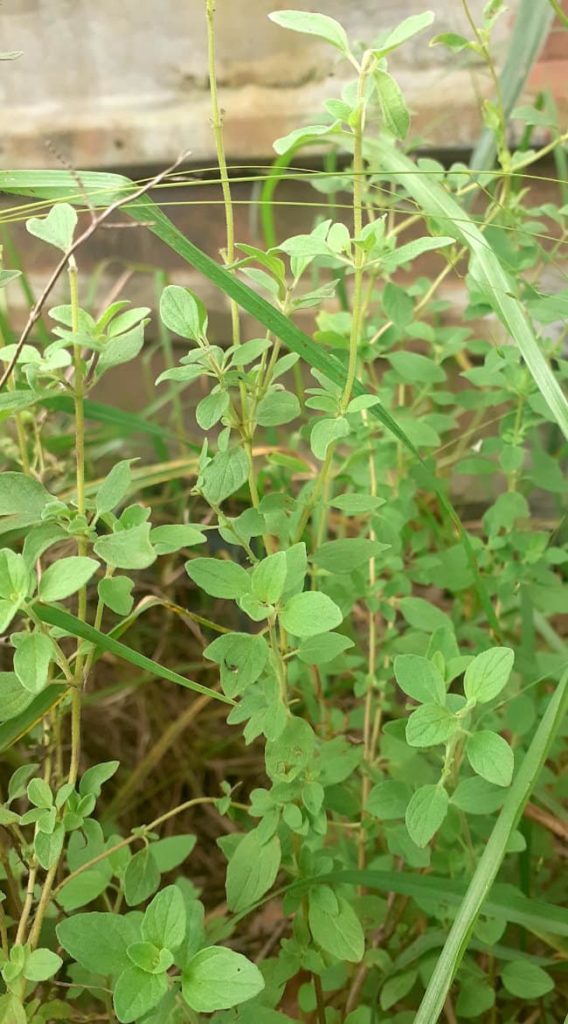
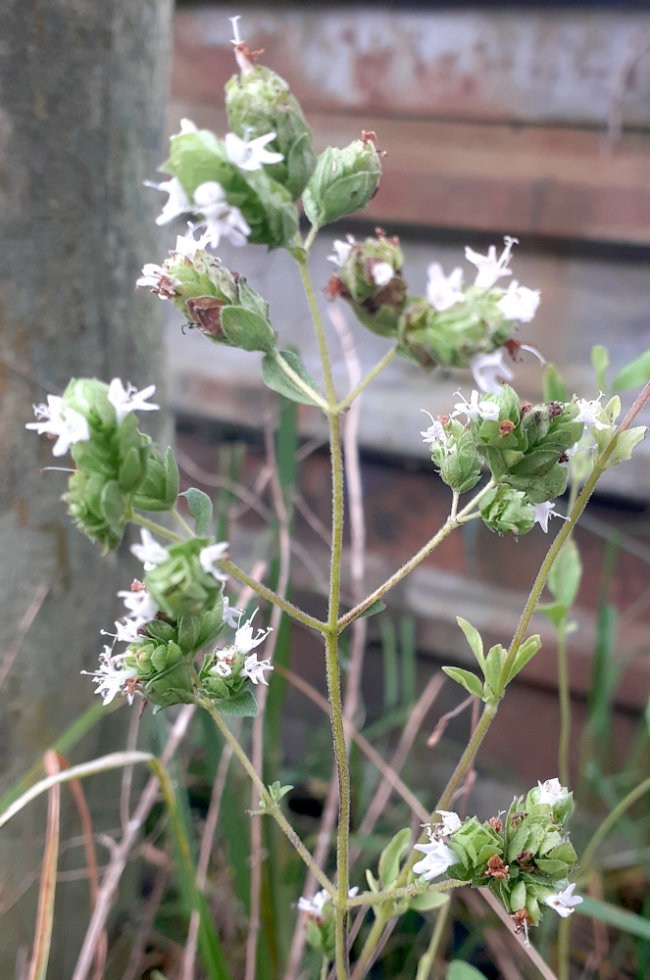
Step One: Harvest
Harvest the oregano by snipping off the branch just below the leaves. The best time to harvest is just before the plant flowers, as this is when it is at its most potent.
As you can see, some of mine have already started to flower, so I also harvested those.
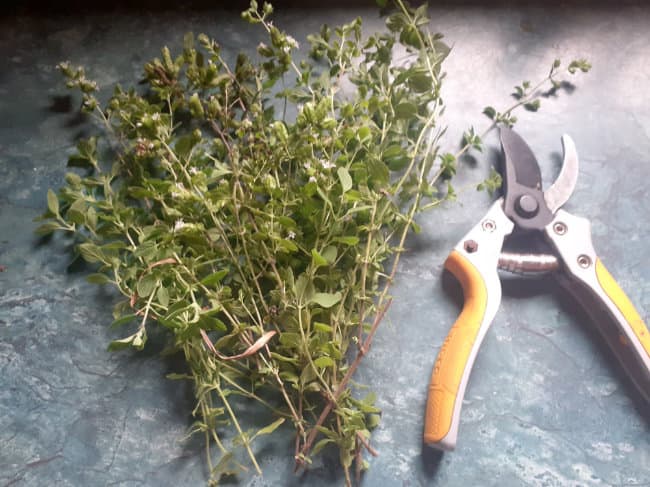
Give your oregano a quick wash to remove any dirt, and then pat dry.
Step Two: Process
I’ve made several different herbal oils over the years and experimented using dried and fresh herbs. I’ve found them to be equally effective, although you do need more fresh herbs than you do dried ones.
As with cooking, when making herbal remedies, one teaspoon of dried oregano is equivalent to a tablespoon of fresh leaves.
I decided to use fresh oregano for this recipe, so I started by stripping the leaves and flowers from the stems.
The easiest way to do this is to hold the tip of the branch between your finger and thumb and then run the fingers of the other hand along the stem. The leaves will strip off in your hand if the stem is woody enough. If the stem is tender, it’s likely to break, but you can add these to your oil with no ill effect.
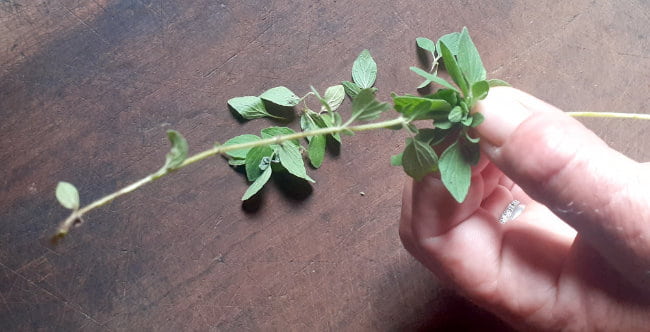
Step Three: Chop or Crush
Once I had a neat pile of flowers and leaves, I started processing them.
I first tried crushing the flowers with a pestle and mortar. While this was effective, it was time-consuming and required too much muscle power.
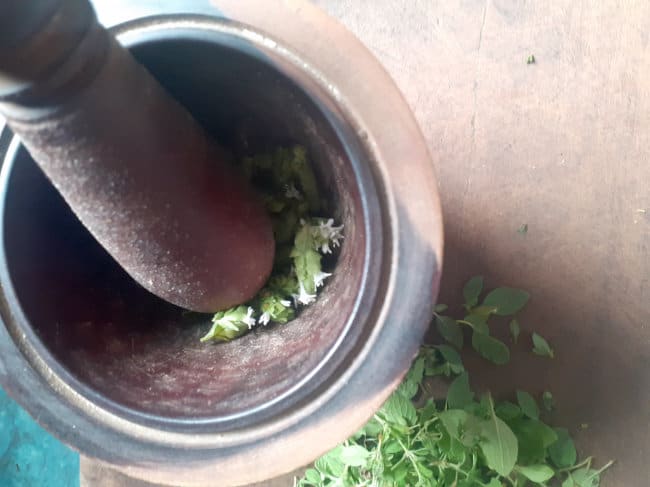
I decided to chop the leaves instead, which proved much quicker but equally successful.
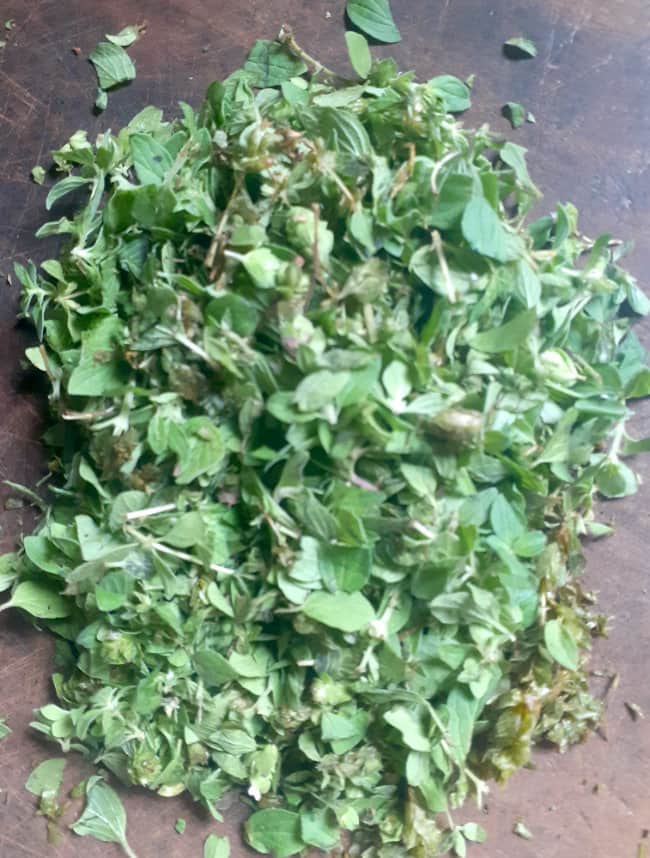
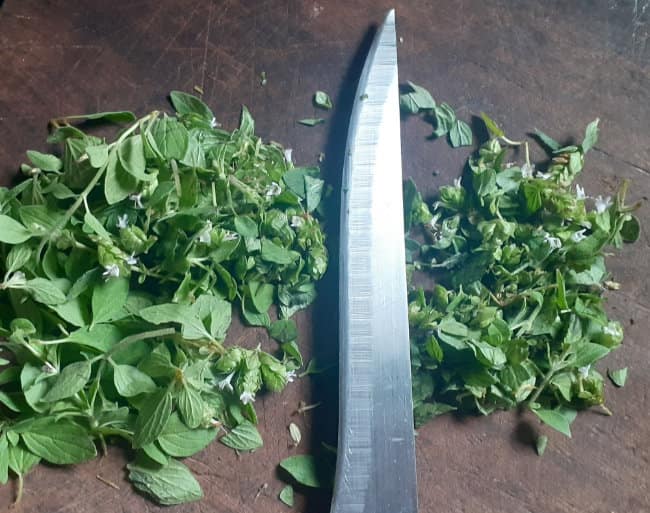
Preparing the Oil
Once your oregano is ready, put it into a clean glass jar and cover it with the oil of your choice, giving it a quick stir before sealing the jar.
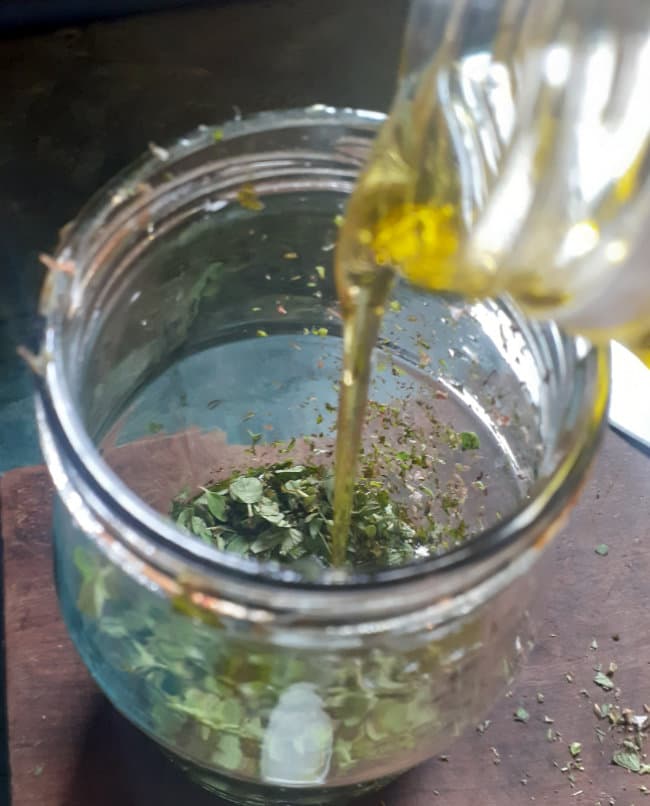
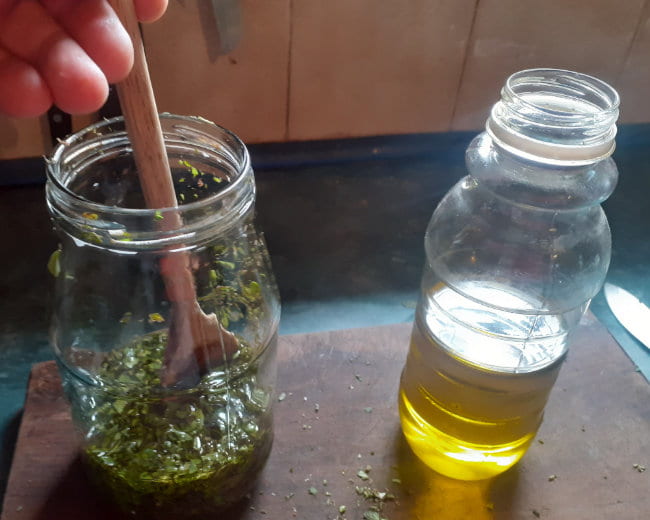
While you’re doing this, heat a saucepan of water. Once the water comes to a rolling boil, turn the heat off, and put the jar, with its herbs and oil, into the saucepan.
Warm the contents for five to 10 minutes to activate the infusion process.
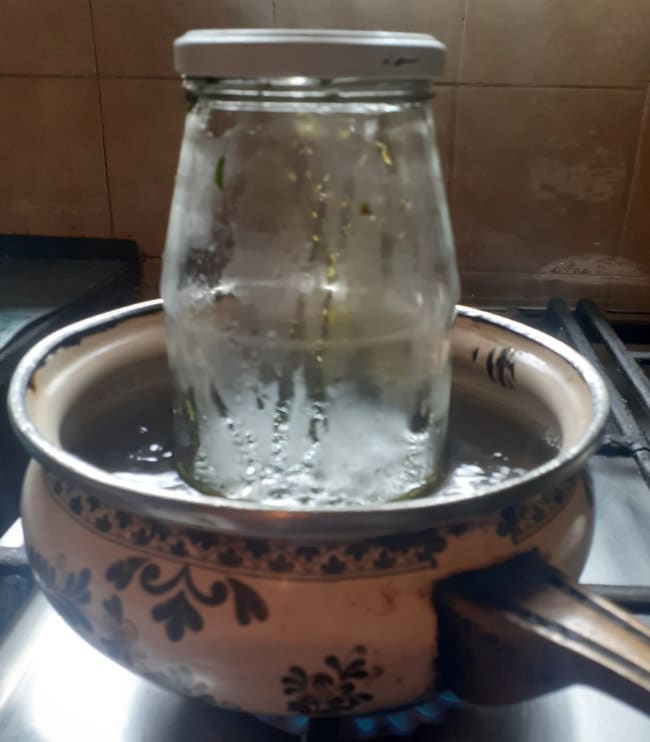
Playing the Waiting Game
Take your jar out of its warm bath, dry it off, and leave it on a windowsill for one to two weeks, making sure you give it a quick shake every day.
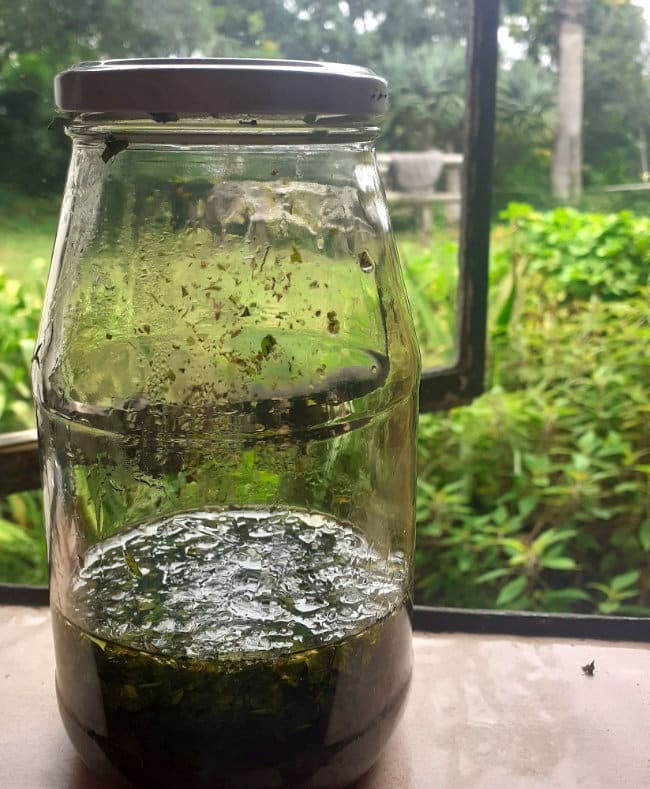
After two weeks, your oil will be potent and ready for use, so strain out the oregano, pour it into a dispensing bottle, and you’re prepared for almost anything.
Homemade oregano oil can last for up to a year if kept refrigerated. If you want to extend its lifespan, add a few drops of grapefruit or lemon oil, which are natural preservatives.
Oregano Oil Uses
Filled with medicinal qualities, oregano is almost an entire first-aid kit packed into one plant. It is antibacterial, anti-inflammatory, anti-fungal, antiseptic, and antimicrobial. Talk about upping the ante!
When it comes to survival, “long-term protection against infection and disease” will prove vital and wild oregano is the Rolls Royce of natural antibiotics.
Not only that, oregano oil “is a potent and effective antimicrobial, so can prevent the spread of dangerous microorganisms.
Recent events reminded us that new viruses could threaten the human population anytime. Having oregano oil on hand to treat respiratory problems, coughs, sore throats, and nasal congestion could ensure survival in a dangerous new world.
Oregano oil can also be used to treat the following, among other things:
- Muscle and joint pain
- Poor digestion
- Intestinal parasites and worms
- Headaches
- Asthma
- Bronchitis
- Athlete’s foot and other fungal infections
- Toothache
- Indigestion
What Components Make Oregano Oil So Powerful?
All types of oregano contain certain therapeutic compounds, known as “phenols, terpenes, and terpenoids.” These are responsible for the herb’s aromatic fragrance and have “powerful antioxidant properties.”
Carvacrol is “the main active compound in oregano oil” and “has been shown to stop the growth of several different types of bacteria.” Meanwhile, thymol is believed to “help protect against toxins and fight fungal infections.”
Furthermore, “the flavonoids and phenolic acids identified in oregano species have exhibited antioxidant, anti-inflammatory properties.”
Not every oregano plant is the same, however, and the potency of your oregano will depend on numerous factors, including “cultivar, geographical localization, weather, daylight, temperature, soil conditions, water stress, [and] harvesting time.”
How To Use Oregano Oil – Externally and Internally
You can apply oregano topically or take it internally, depending on what you’re trying to treat. If you’re using therapeutic-grade essential oregano oil (Amazon link), mix it with a carrier oil, like coconut or jojoba oil, before applying it. It’s much stronger than a homemade oil, which you can use directly without dilution.
Apply oregano oil externally as a massage oil to treat muscle and joint pain or topically for fungal infections like athlete’s foot, warts, acne, and other skin complaints.
Add a few drops of oregano oil to a steam bath and inhale for respiratory issues, asthma, bronchitis, coughs, and congestion. Before doing this, be aware that some people are allergic to oregano oil, and inhaling it “can cause inflammation of the airways.”
When taking oregano oil internally, the first thing to be aware of is that it tastes terrible! It should always be diluted for internal use, and mixing it with a carrier oil like coconut or olive oil can help it go down a little easier. Honey is also a good way of disguising the taste.
Being a “hot oil,” it can burn the skin, the throat, and internal organs, so caution is required.
Is It Better To Buy Therapeutic Oregano Oil Or Make Your Own?
One of the benefits of making your own oregano oil is that you can control its potency and experiment with your recipe until you find the right strength for your needs.
You can also experiment with dosage and application, whereas an essential oregano oil is more limited as it’s not recommended for internal use.
Not only is over-the-counter oregano oil expensive, but it also varies in strength and may contain alcohol, GMO ingredients, chemicals, and preservatives.
In a survival situation, there’s no guarantee that you’ll be able to buy anything, let alone niche products like herbal oils, which is why growing the herbs and concocting your own remedies will give you the advantage when the SHTF.
Are There Any Scary Side Effects of Using Oregano Oil?
Although oregano oil has many benefits, as with any medicine, it has a similarly long list of warnings.
Some people are allergic to oregano oil and may develop a rash if using it topically or stomach problems and respiratory issues if taken internally. Even if you’re not allergic to oregano oil, it can still be toxic because it is “such a powerful antimicrobial agent.” “Taken in large doses, oregano oil can even be lethal.”
People with diabetes should also use oregano oil cautiously as it may lower blood sugar levels. It can also increase the risk of bleeding, so it should not be used before surgery or in conjunction with medicines designed to slow blood clotting, like aspirin, heparin, or warfarin.
Oregano is considered “POSSIBLY UNSAFE when taken by mouth in medicinal amounts during pregnancy,” There is also “concern that oregano in amounts larger than food amounts might cause miscarriage.”
If taking oregano oil internally, please err on the side of caution, and stop after ten days, waiting another ten days before recommencing the treat.
Conclusion
Oregano oil has an abundance of health benefits and medicinal properties.
It’s easy to make your own, and the end product will be effective against everything from the common cold to worms and warts.
Homemade oregano oil may not be as potent as a 100%-therapeutic-grade essential old, but even that is a benefit in some respects. Homemade oil is safer to take internally and less likely to burn the skin when used topically.
Oregano oil can kill almost any bacteria and doesn’t have a shelf-life like most antibacterial pharmaceuticals, making it almost essential for virtually any emergency or survival situation.
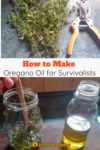


Could I use avocado oil as the carrier?
I’m concerned that the neighbors cat has been peeing in my herbs, and the area has an oder as of so. Do you recommend spraying or dunking in apple cider vinegar, or what do you suggest?
How much of the prepared oregano oil would an adult take for a sore throat?
oregano grows like wildfire here in the CA foothills, in rocky sandy soil. I grow several kinds, and marjoram seems similar. The one with purplish flowers is the most beautiful – and I’m letting it grow outside my vegetable beds. Looking forward to following your exlnt directions to make some oregano oil. thank you.
Thank you! I found this article very informative and I’m going to try it!
I was going to use it for tooth pain, so would you recommend I put the oil on some cotton or add directly to the tooth? Also wondered if it was safe to use a very small amount for teething children?
Can you use diluted oregano oil for gum health and canker sores?
I bought oregano oil but it says for extarnal use only. I had some orally and I am still alive. The makler told me not to use internally. Do you think I could just dilute it ? Majestic Pure brand
Thank you
Can you save the leftover oregano leaves after straining out the oil? Can it be used for cooking?
Hi. Should the oil of oregano mixture be thick or oily to store before it’s ready to be strained for use?
Before it’s strained, it will look like oily plants. The oil itself doesn’t get thick.
I forgot to boil the jar before putting it in the cabinet to stew. Toss and start over, or boil now (8-10 days ago)?
TIA!!
Dried or fresh oregano? I only ever infuse oils with dried herbs and I cover them in oil and shake the jar and store in a cupboard for 4 to 6 weeks and then strain and I’ve never had an issue with them being bad. I would say it’s fine no need to boil now. I believe heating just infuses the oil faster but you can also just store longer before straining to get the infusion.
So I used fresh oregano and olive oil,,,with a warm bath. Should I let it set in a cool dark spot before straining ?
Most methods say keep in a cool dark place and they also say place on the windowsill this seems like a contradiction as it is sunny and hot what is the best way to steep diy olive oil
There are a few different ways of making oregano oil. I usually use dried herbs and soak them in oil (in a dark, cool place) for 2-3 months before straining the oil. Nicky used fresh oregano in this method. The hot bath and leaving in sun speeds up the process but, yes, can kill some of the antioxidants in the process.
Hi Diane,
I did mine but I forgot to do the hot bath, however, I would put in the sun whenever we had sunny days ( not that many in Milwaukee 🙁 ) and I have had it also in a cool place for now probably two months.
So I have done both sides of the process. I just tasted it and it tastes ok., so should it be fine? now I can put it in the fridge?
Thanks!
How do you know if the oregano oil is bad?
Oils get a weird taste and smell when they go rancid. It can be sour or even fishy!
I bought dried oregano in bulk and I’m wondering if I can use that. It’s the same stuff used for cooking.
I too need to know the answer to this last question, I bought a big bottle of oregano at Costco, can we use that yo make our oregano oil
Yes but it’s not as potent as wild oregano as stated in the article
Does this need to be refrigerated after the 2 weeks on the windowsill? I made a batch without doing a warm bath and left it in my cupboard for about a month (I forgot about it).
Can this be made with coconut pill instead of olive?
Yes, definitely!
My first batch turned out great, but second turned a dark green need to know if it’s safe and why it turned so dark
If you used the same oregano, then the color difference might be due to temperature differences when soaking. If it was hot while you soaked the oregano, it would cause more of the plant matter to get into the oil and faster.
When taking orally what amount should we take and how often? I hear you should start off small to test your reaction to it. So whats the amount and how often for testing and then once you know its safe for you, what’s the amount and how often then?
Did you ever find out? I just made some, and will start tacking some maybe next week. 🙂
There is no set dosage. Usually you would take about 5 drops 1-3 times per day. I’ve taken more (1 tsp 3x per day) when I had food poisoning. And, yes, it’s always a good idea to take a very small amount and see how your body reacts to it.
What amounts of oregano and oil do I use?
Enough to make sure the oregano is completely covered. I usually cover it with oil and then wait 15 minutes. The dry herb will absorb the oil during these 15 minutes. Then I will add more oil — enough that there is at least a 1/4 inch layer of oil floating on top of the herb.
What ratio of herbs to oil should I use?
how do you take this internal? like worms?
You consume it. I usually mix my medicinal oils and tinctures with mashed raspberries because it masks the gross taste. You maybe could take an oregano oil suppository but I’m not sure about that one!
Do you treat dried herb the same? Like do you just cover dried herb as you do with fresh or more oil with dried?
You’ll probably need a bit more oil with dried herb because it will absorb a lot of the oil.
You really want to use only dried or at least mostly dried herbs when making an oil. “Wet” herbs will more likely become moldy from the water content. You use fresh herbs with alcohol for tinctures instead.
You are my #1 source of survival information and the first place I refer people to when they ask me questions. Thank you.
excellent article—thanks…saved it for later use,
keebler
So I made cold pressed oregano oil. Half jar organic wild picked greek oregano, and filled jar with organic cold pressed olive oil. I let sit in airtight jar for roughly 6-8 weeks shaking it every couple days. I am just not sure how to guide myself on dosing out for internal consumption. Since it wasnt heated and not 100% therapeutic grade or essential oil etc. So should I do like 0.5ml (on my dropper) like 2 to 3 xs a day for 7 to 10 days? Just not sure how much to take any thoughts woukd be greatly appreciated! Thanks.
Dosing is always really tricky with DIY medicinal oils. For starters, you can’t tell how potent the plant was (soil quality, plant age, etc. all effect the potency of the plant). Regardless, it’s wise to start with a lower dose of any natural remedy to make sure you don’t have a reaction, and then gradually increase the dosage.
Hi, i am from the Philippines. We have oregano plants here but it is very different from the one you have shown. It’s watery and has soft stem with about 1/4″ to 3/8″ diameter stem. When left to grow on its own it cannot grow erect unless supported. But it’s aromatic too as you describe, but its very watery, life if you press the leaves or stem with you fingers it has a lot of juice in it. Could this be a different plant? But we also use for cold or tea.
There are LOTS of different types of oregano. I would find the latin name for your species. It also almost certainly has medicinal properties though. 🙂